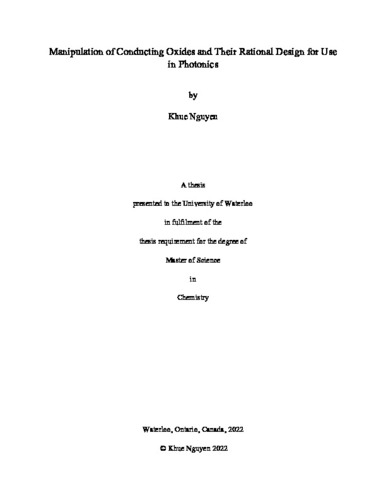| dc.contributor.author | Nguyen, Khue | |
| dc.date.accessioned | 2022-06-02 13:58:03 (GMT) | |
| dc.date.available | 2022-06-02 13:58:03 (GMT) | |
| dc.date.issued | 2022-06-02 | |
| dc.date.submitted | 2022-05-26 | |
| dc.identifier.uri | http://hdl.handle.net/10012/18347 | |
| dc.description.abstract | Transparent conducting oxides (TCOs) have been largely studied for their applications in light emitting diodes (LEDs), photodetectors, solar cells, and other photonic uses. TCOs are useful as they can be doped or alloyed to tune specific properties such as photoluminescence (PL), allowing them to emit light spanning the entire visible region or near UV. Considering literature and research from the Radovanovic group, the TCO gallium (III) oxide (Ga2O3) and cerium oxide (CeO2) were selected to be modified via doping, alloying and surface treatments to design functional nanoparticles (NPs). Cerium oxide nanoparticles (CNPs) were synthesized with varying surface modifiers to enhance their UV emission. Low temperature PL data of tri-octylphosphine oxide (TOPO) surface treated CNPs reveal a novel UV emission theorized to originate from the charge transfer (CT) between Ce3+ and TOPO ligands, and Ce3+ intracentre transitions (5d-4f). Lanthanides were then introduced into the CNPs as dopants to further functionalize CNPs. Erbium cerium oxide NPs demonstrated a novel white light emission, that could be useful in future white LED applications. Functionalization of CNPs by lanthanide incorporation is also explored through sensitization of Tb3+ ions. The synthesis of γ-gallium oxide (γ-Ga2O3) is also studied herein, and several synthesis parameters were tuned. Aluminum will be used as an alloying species because aluminum oxide (Al2O3) can form a defective spinel lattice structure like γ-Ga2O3 allowing it to easily form an alloy structure. Al2O3’s larger band gap energy allows band gap manipulation in alloyed aluminum gallium oxides (AGOs) NPs. The results indicate an increase in band gap energy and an emission shift to the UV region as aluminum concentration is increased. Overall, the results found herein the thesis demonstrate the use of rational design and nano-engineering to achieve novel and useful metal oxide NPs for potential applications in photonics and beyond. | en |
| dc.language.iso | en | en |
| dc.publisher | University of Waterloo | en |
| dc.subject | nanoparticles | en |
| dc.subject | photonics | en |
| dc.subject | cerium oxide | en |
| dc.subject | photoluminescence | en |
| dc.subject | lanthanide | en |
| dc.subject | gallium oxide | en |
| dc.title | Manipulation of Conducting Oxides and Their Rational Design for Use in Photonics | en |
| dc.type | Master Thesis | en |
| dc.pending | false | |
| uws-etd.degree.department | Chemistry | en |
| uws-etd.degree.discipline | Chemistry | en |
| uws-etd.degree.grantor | University of Waterloo | en |
| uws-etd.degree | Master of Science | en |
| uws-etd.embargo.terms | 0 | en |
| uws.contributor.advisor | Radovanovic, Pavle | |
| uws.contributor.affiliation1 | Faculty of Science | en |
| uws.published.city | Waterloo | en |
| uws.published.country | Canada | en |
| uws.published.province | Ontario | en |
| uws.typeOfResource | Text | en |
| uws.peerReviewStatus | Unreviewed | en |
| uws.scholarLevel | Graduate | en |

